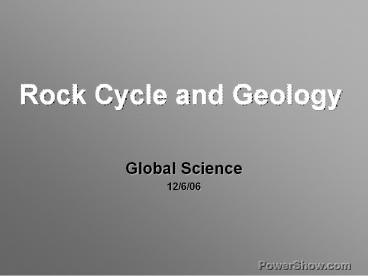Rock Cycle and Geology - PowerPoint PPT Presentation
Title:
Rock Cycle and Geology
Description:
Rock Cycle and Geology. Global Science. 12/6/06. What are the 3 types of rock? ... Extrusive igneous rock: formed when magma cools quickly on the earth's surface ... – PowerPoint PPT presentation
Number of Views:334
Avg rating:3.0/5.0
Title: Rock Cycle and Geology
1
Rock Cycle and Geology
- Global Science
- 12/6/06
2
What are the 3 types of rock?
3
Igneous Rock
- Igneous Rock Rock formed from cooled
- magma.
- Extrusive igneous rock formed when magma cools
quickly on the earths surface - Intrusive igneous rock formed when magma cools
over time inside the earth.
4
Sedimentary Rock
- Sedimentary Rock Rocks formed
- from sediment layers on the earths
- surface due to weathering.
5
3 Sedimentary Rock Types
- Clastic rock made from fragments of
other rocks and minerals. - Chemical rock formed from solutions
of minerals and water
(Sandstone) - Organic limestone rock and rock
formed from calcium carbonate (ocean
animals).
6
How Sedimentary Rock Forms
Pre-existing Rock
Weathering
Sediment Forms
Erosion
Compaction Cementation
Sedimentary Rock
7
Metamorphic Rock
- Metamorphic Rock (Meta New)
- Rock formed from a change in pre-existing rock
- usually due to increased heat and pressure.
- Igneous, Sedimentary and Metamorphic rock
- can change to become new metamorphic rock.
8
Metamorphic Rock
- Foliated
- (Patterned like pages in a book)
- Mineral crystals are in line
- Non-Foliated (Non-patterned)
Gneiss
Marble
9
Metamorphic
Slate
10
Metamorphic
Marble
11
Rock Cycle
Weathering, Erosion
Deposition
Sedimentary Rock
Cementation (Pressure, Temperature)
Metamorphic Rock
Melting
Cooling
(Magma)
Igneous Rock
Weathering
12
Cementation
Heat and Pressure
13
Cementation
14
Minerals
- What is a mineral?
- Crystalline structure crystal structure
- Solid cannot be a liquid or gas
- Formed in nature only not man-made
- Nonliving not made of living organisms
15
Crystal Structure
Atoms bind together to form molecules.
Atoms
16
Identifying Minerals
- Color (Minerals can come in many varieties)
- Streak color of a mineral in a powder form
- Cleavage the way a mineral breaks
- Hardness Determined by Mohs scale of hardness
- Density mass per volume
- Luster
- Metallic Shiny
- Submetallic In-between metallic and nonmetallic
- Nonmetallic (Dull)
17
Types of Minerals
- Silicate Minerals minerals containing the
elements of Silica and Oxygen.(SiO2) - Examples Feldspar, Mica, Quartz
- Nonsilicate Minerals minerals that do not
contain combinations of Silica and Oxygen. - Examples Native Elements (Gold (Au), Platinum
(Pt), Diamond (C), Copper (Cu), Sulfur (S), and
Silver (Ag).
18
More Non-Silicate Examples
- Carbonates (CaCO3) Calcite
- Halides Fl, Cl, I, or Br combine with Na, K, or
Ca. (NaCl) Salt, (CaFl2) Fluorite - Oxides Al or Fe (Iron) combines with Oxygen.
- (Al2O3) Aluminum Oxide or Corundum
- (Fe3O4) Iron Oxide or Magnetite
- Sulfates Gypsum
- Sulfides Pb, Fe, or Ni combined with Sulfur
(PbS) Galena
19
Special Properties
- Fluorescence UV light (glow or not?)
- Chemical Reaction acid RxNs?
- Optics double images?
- Taste salty or not? (Halite)
- Magnetic does it attract iron (Fe)?
20
Clastic
Back
21
Sandstone
Back
22
Limestone
Back































